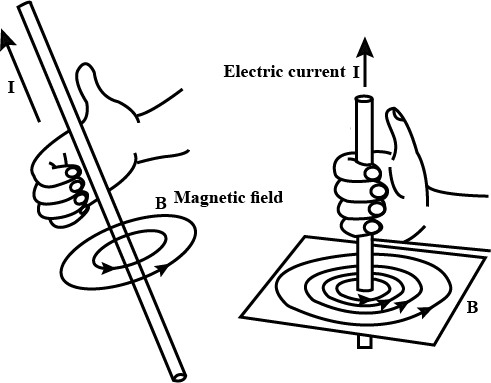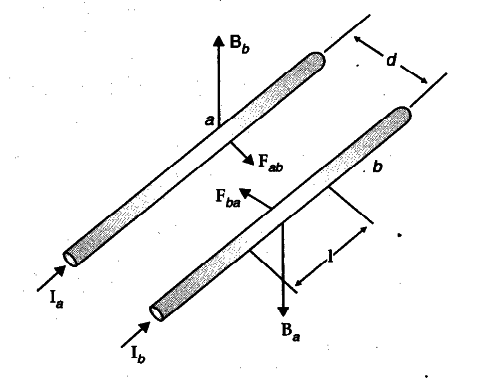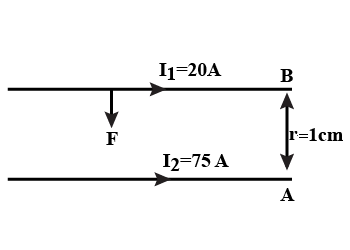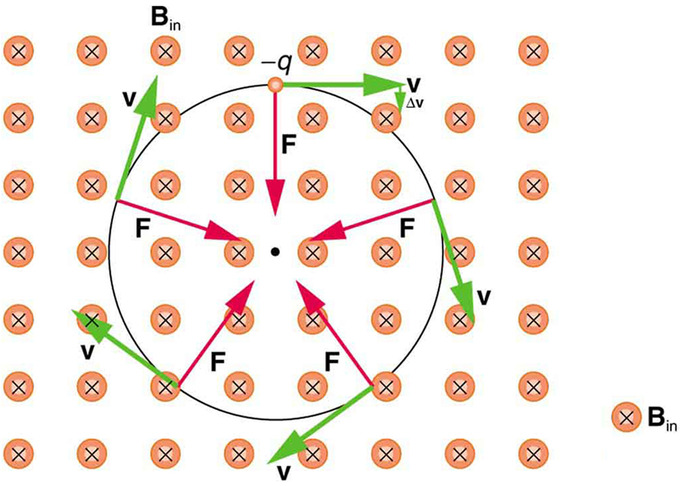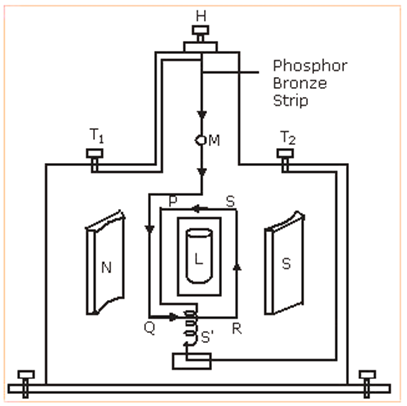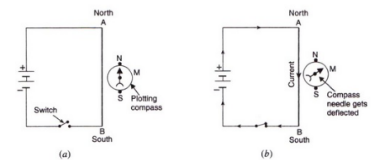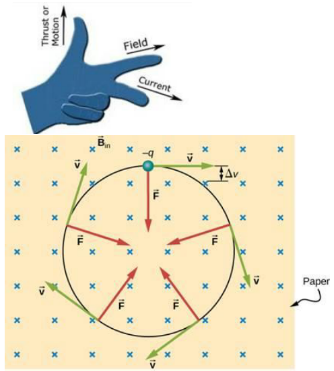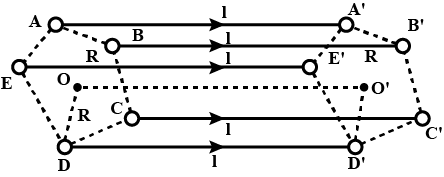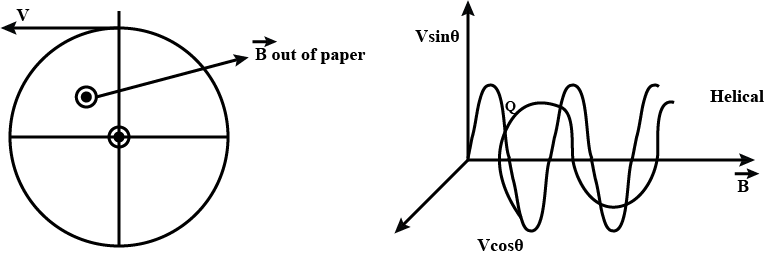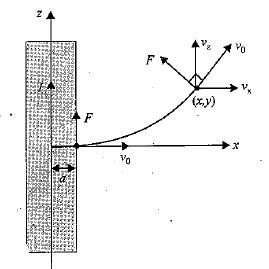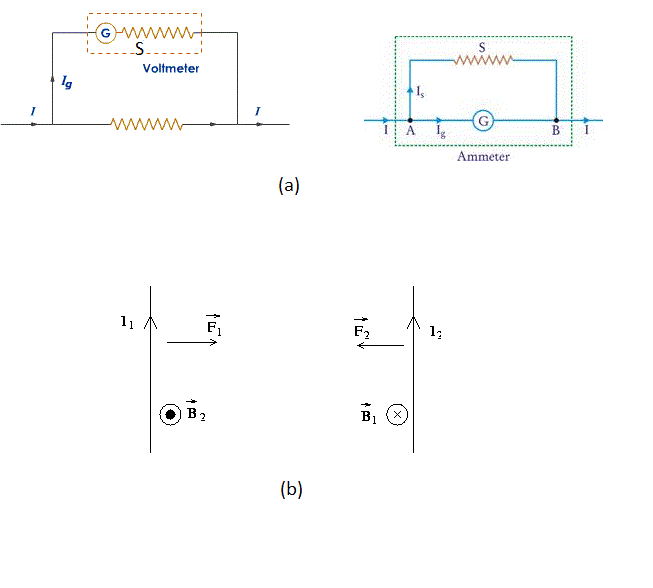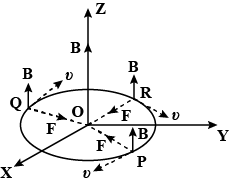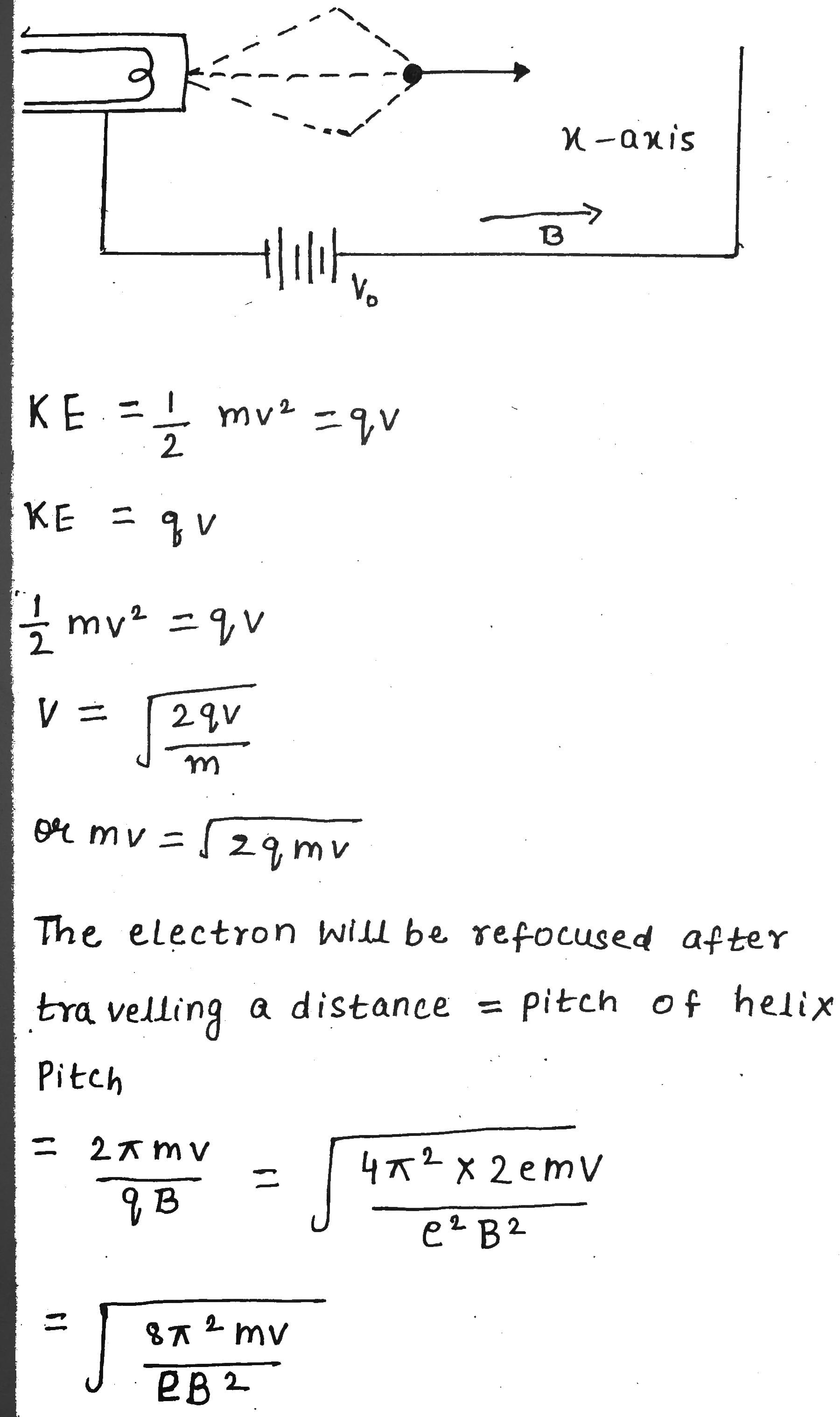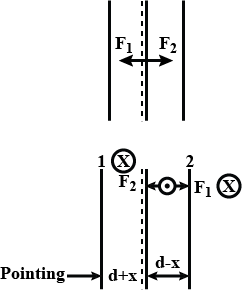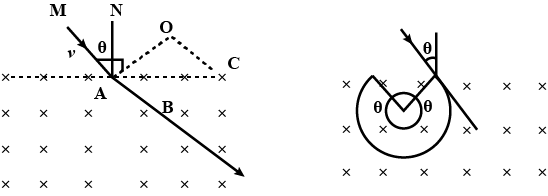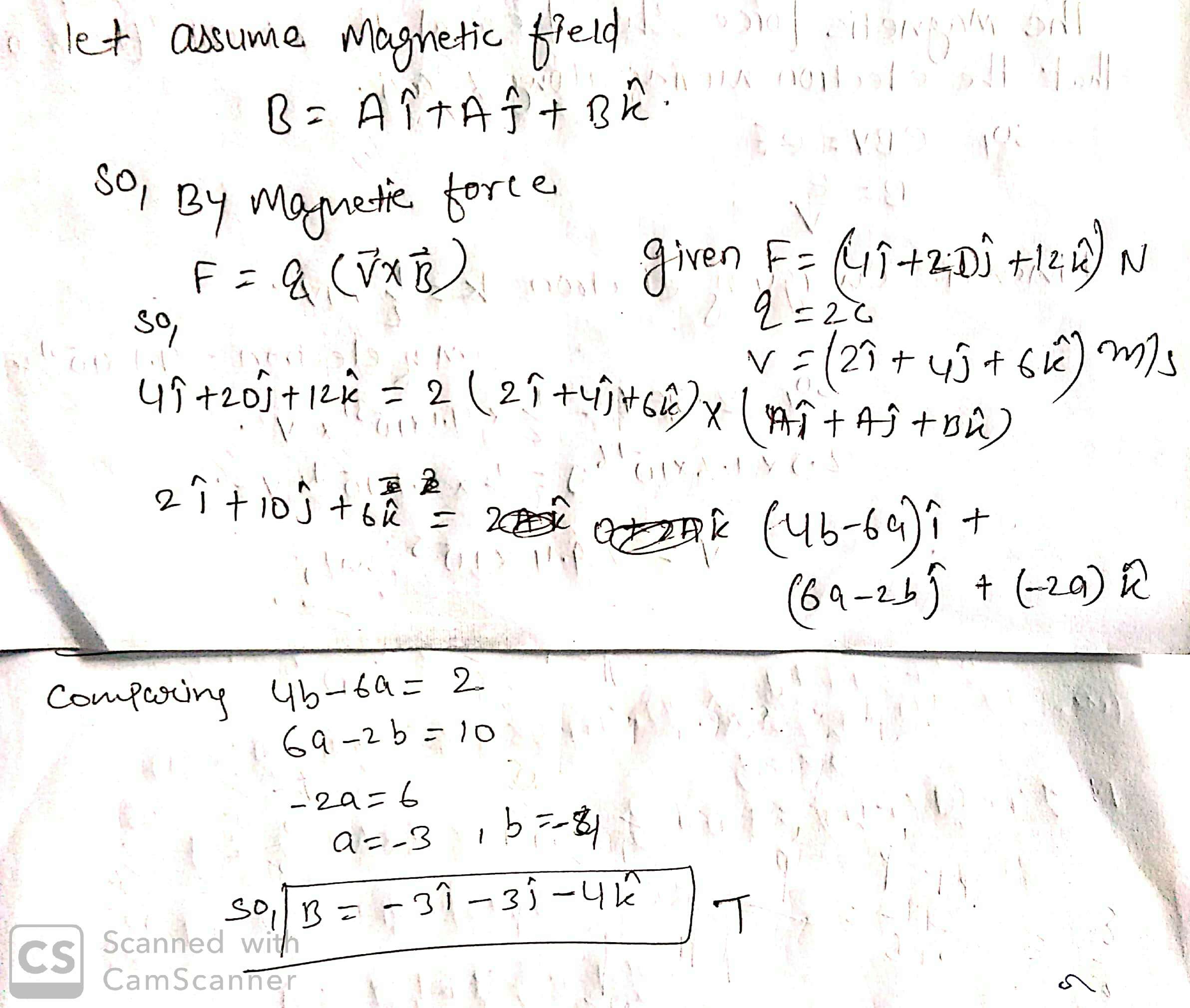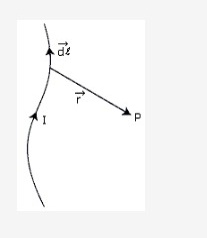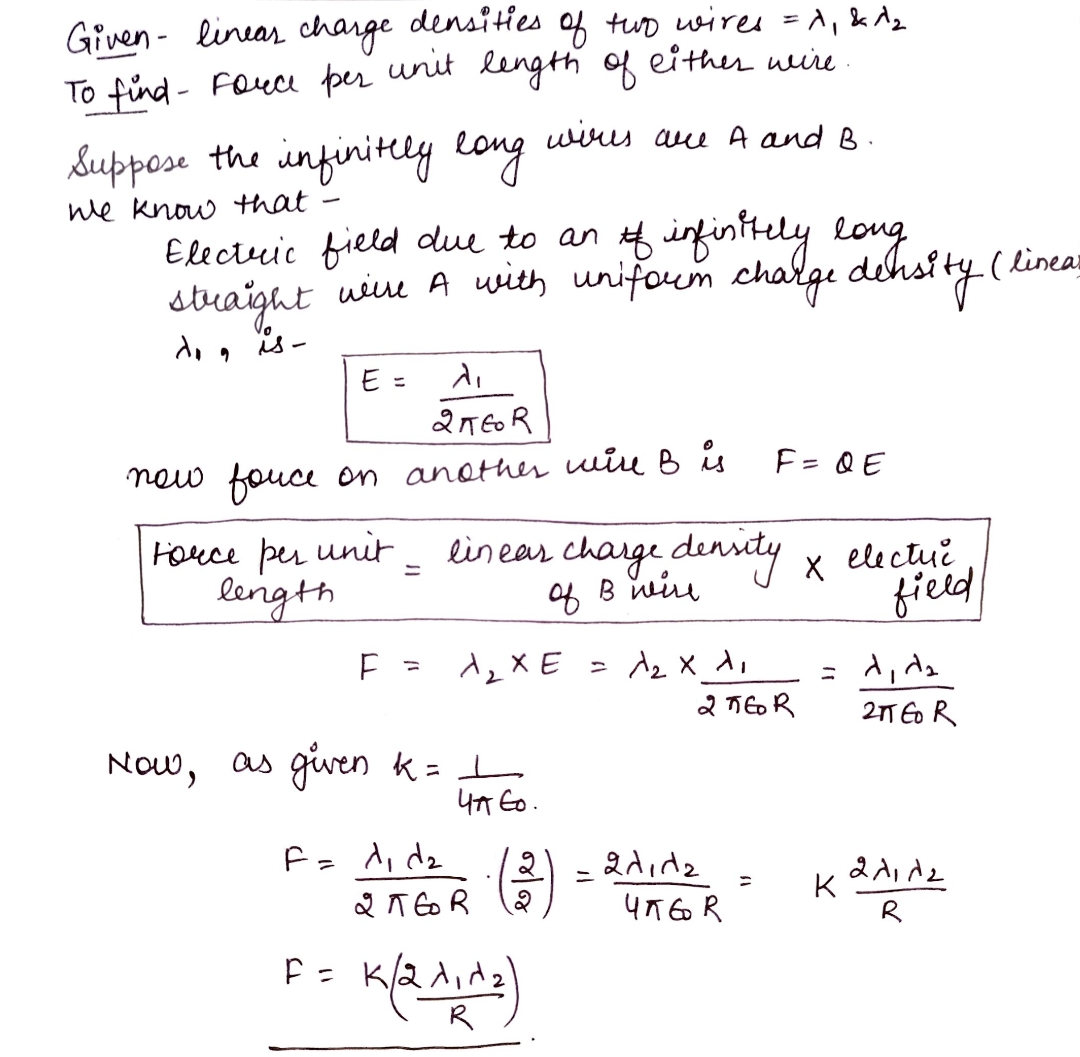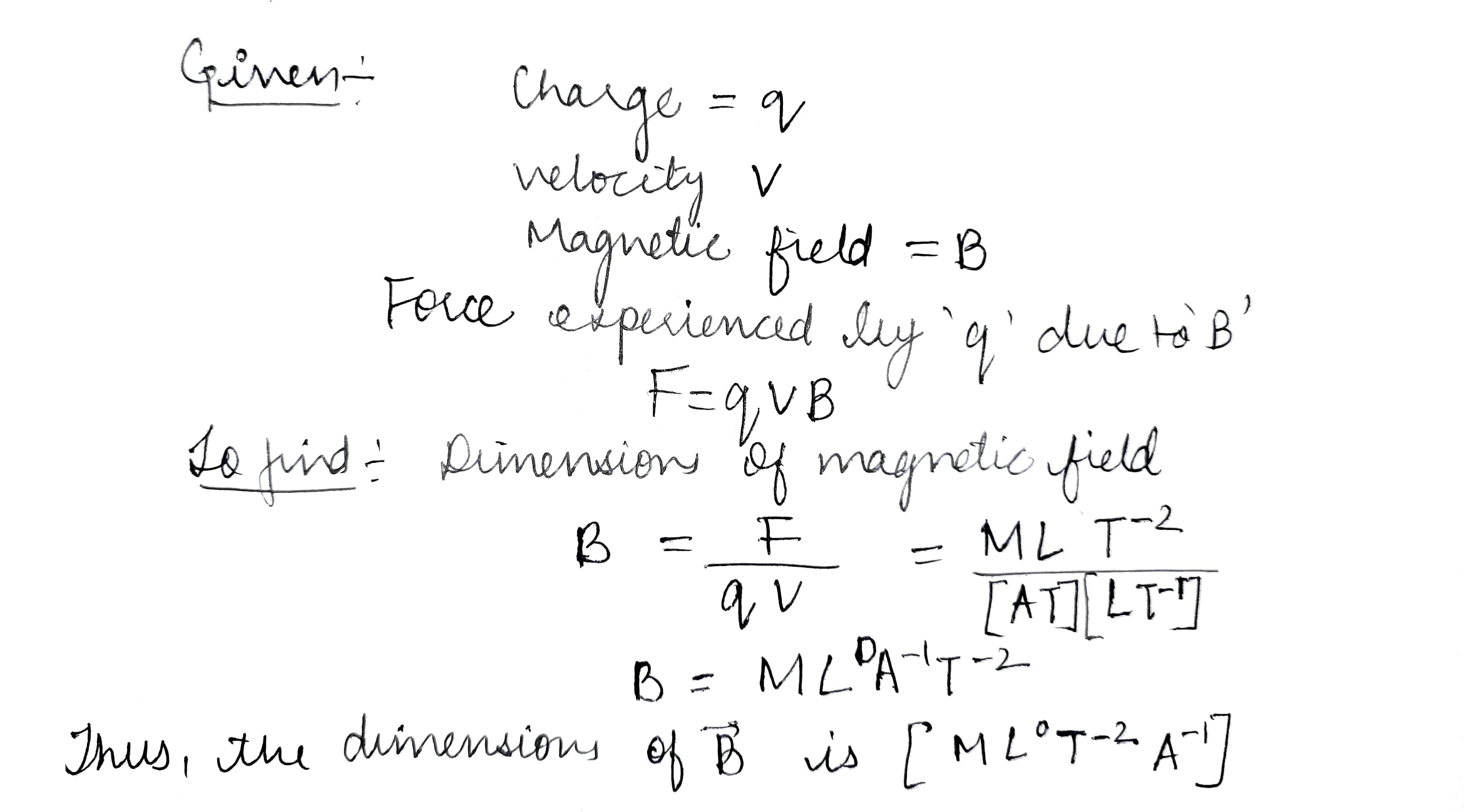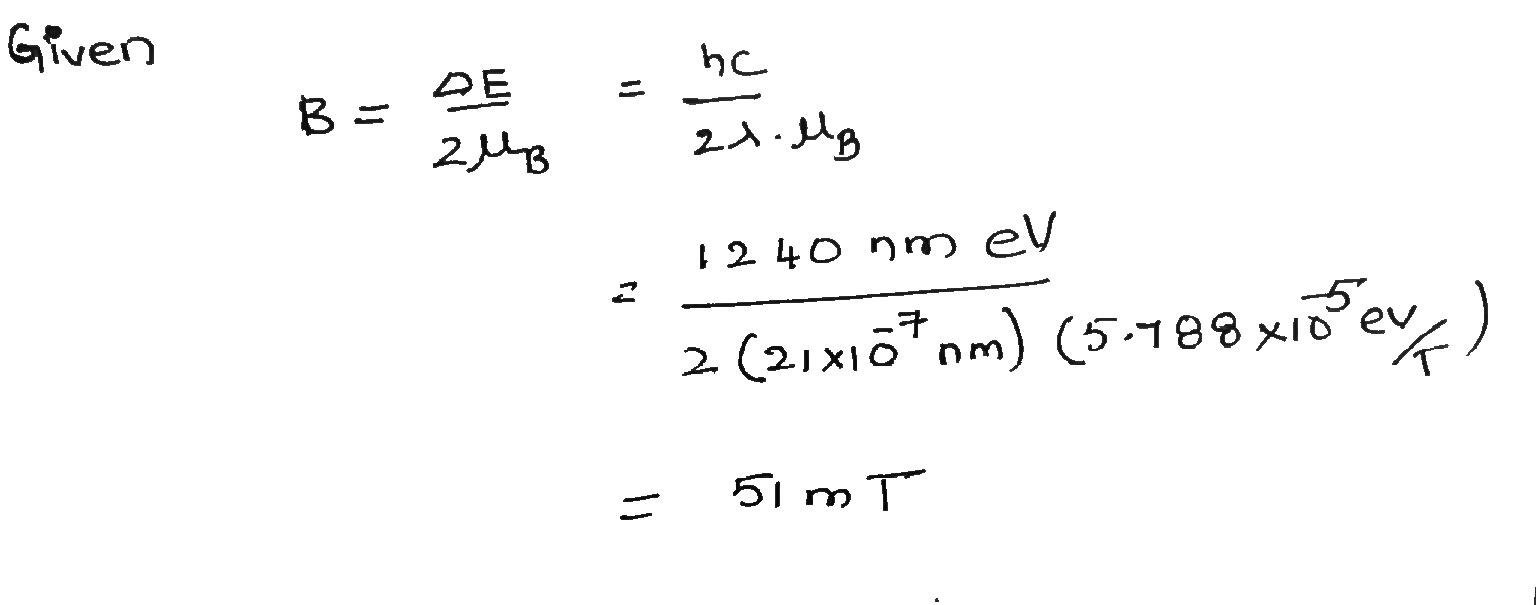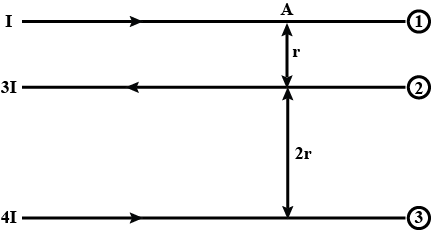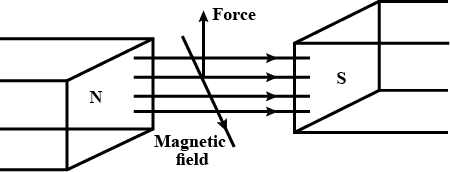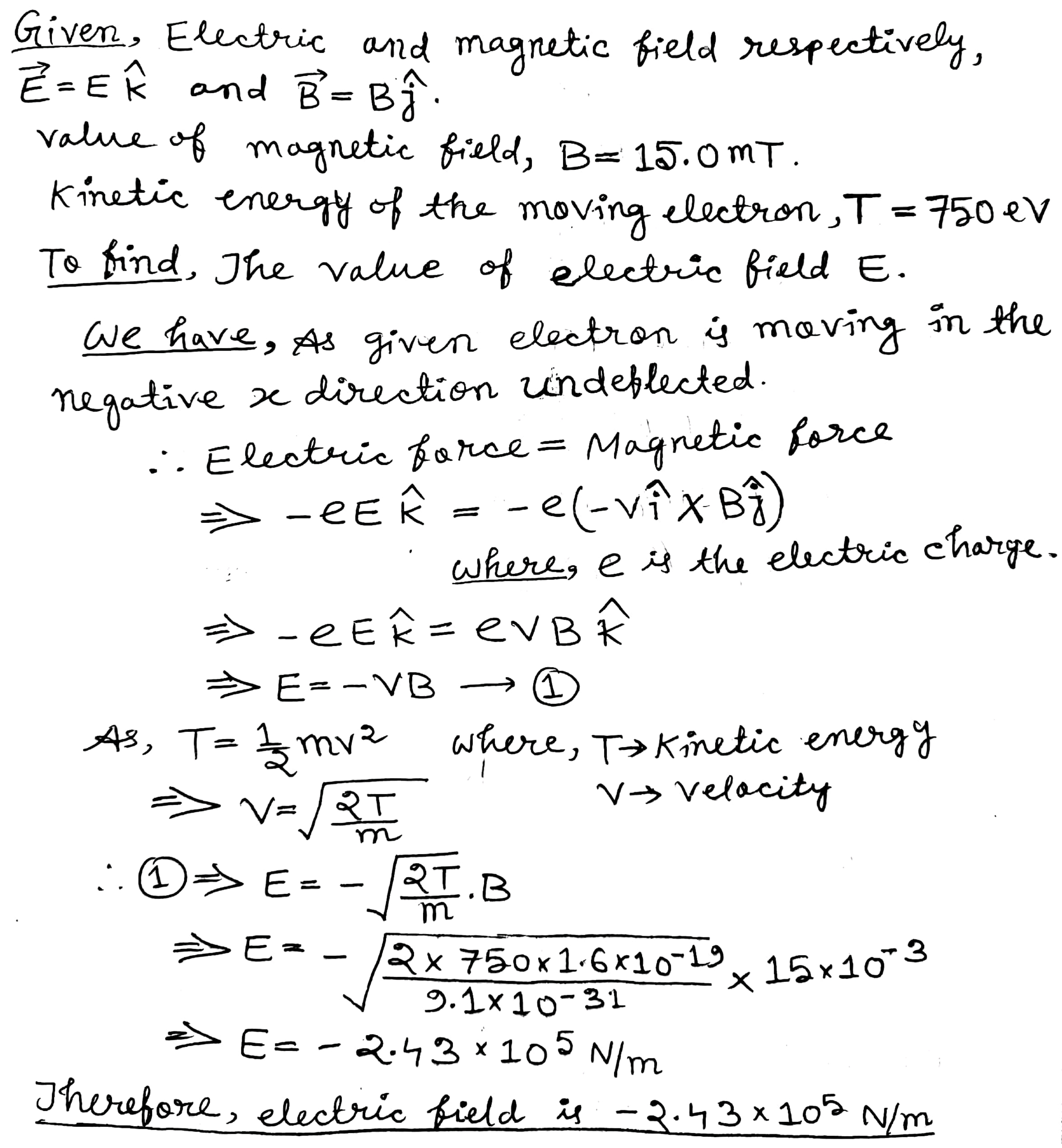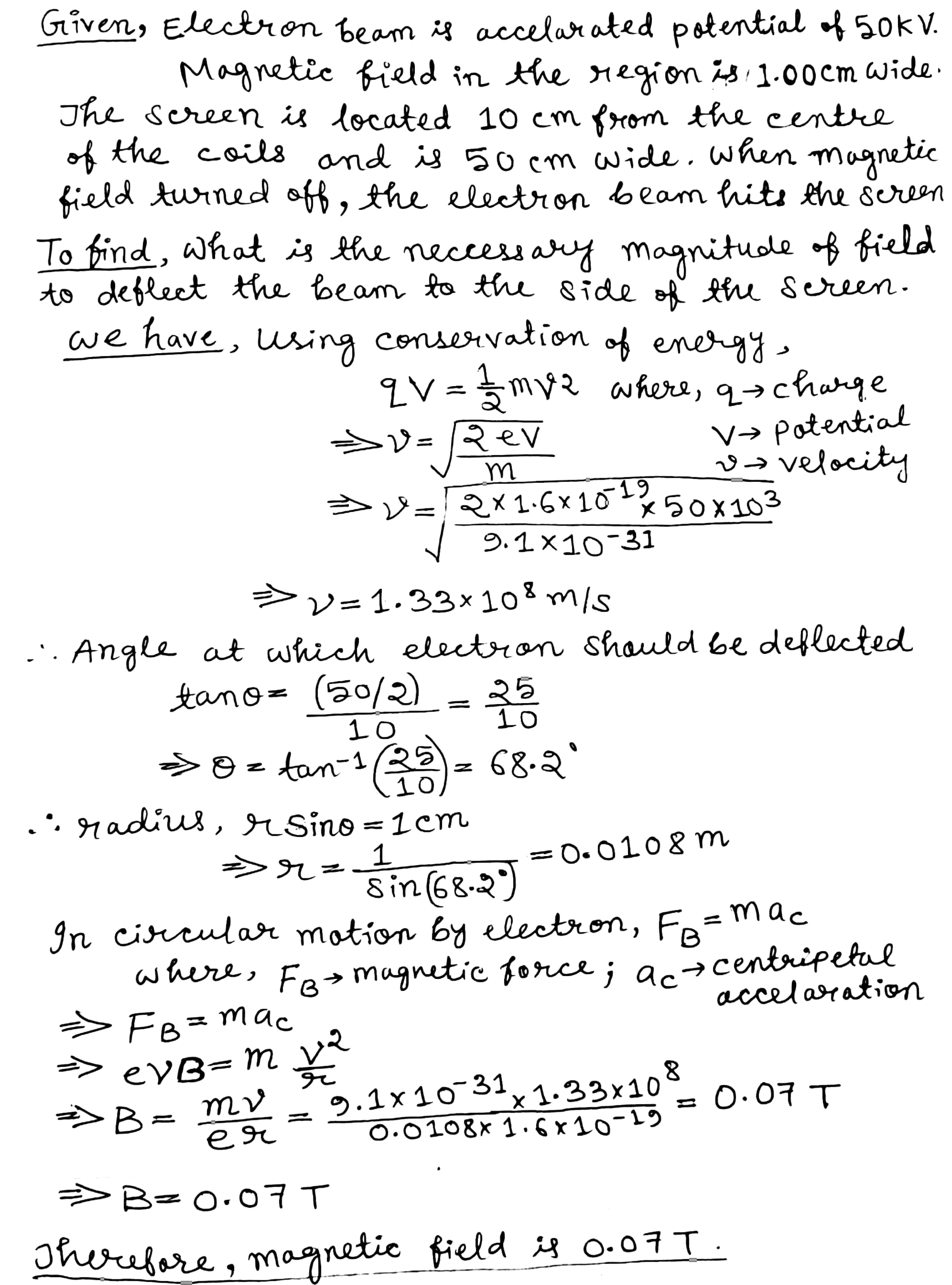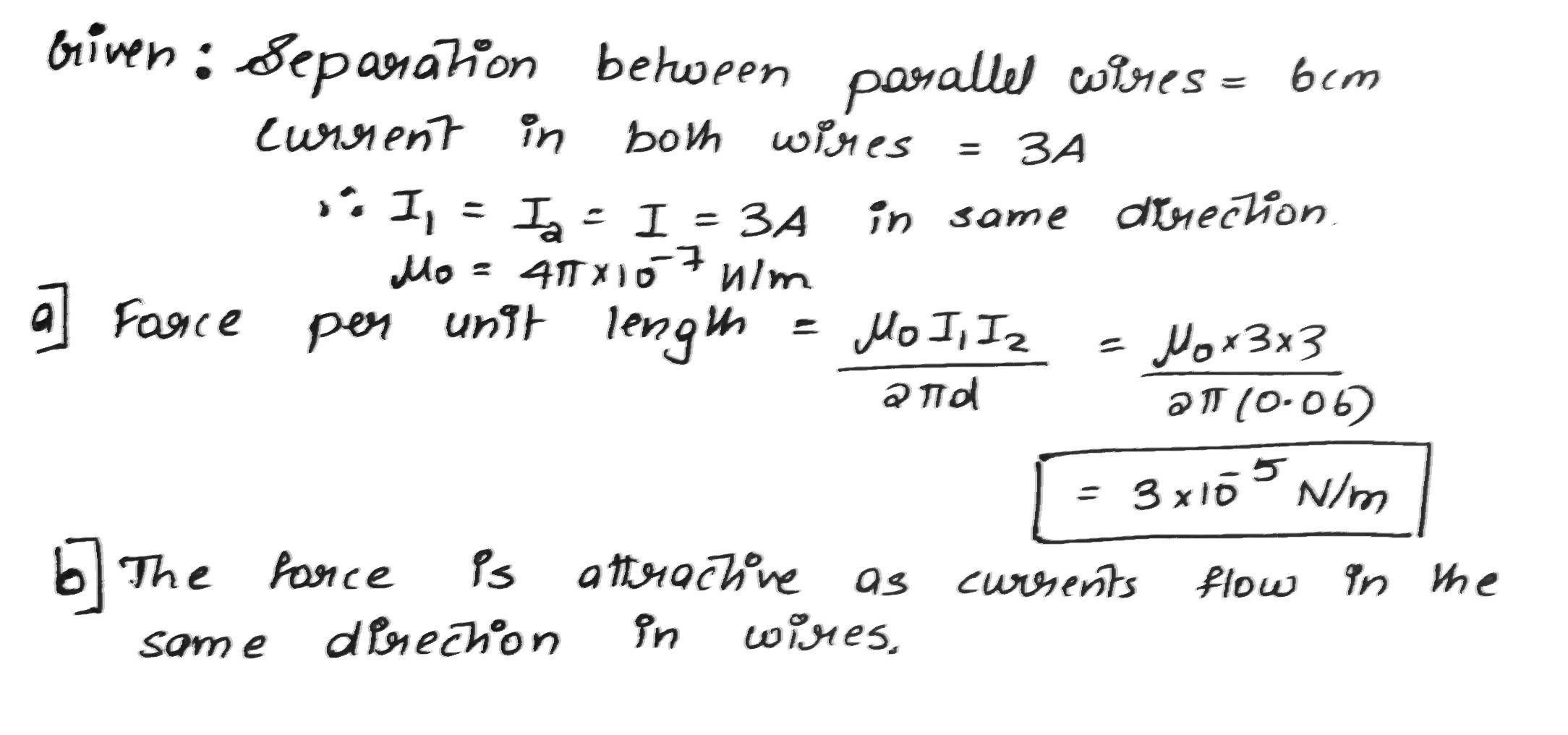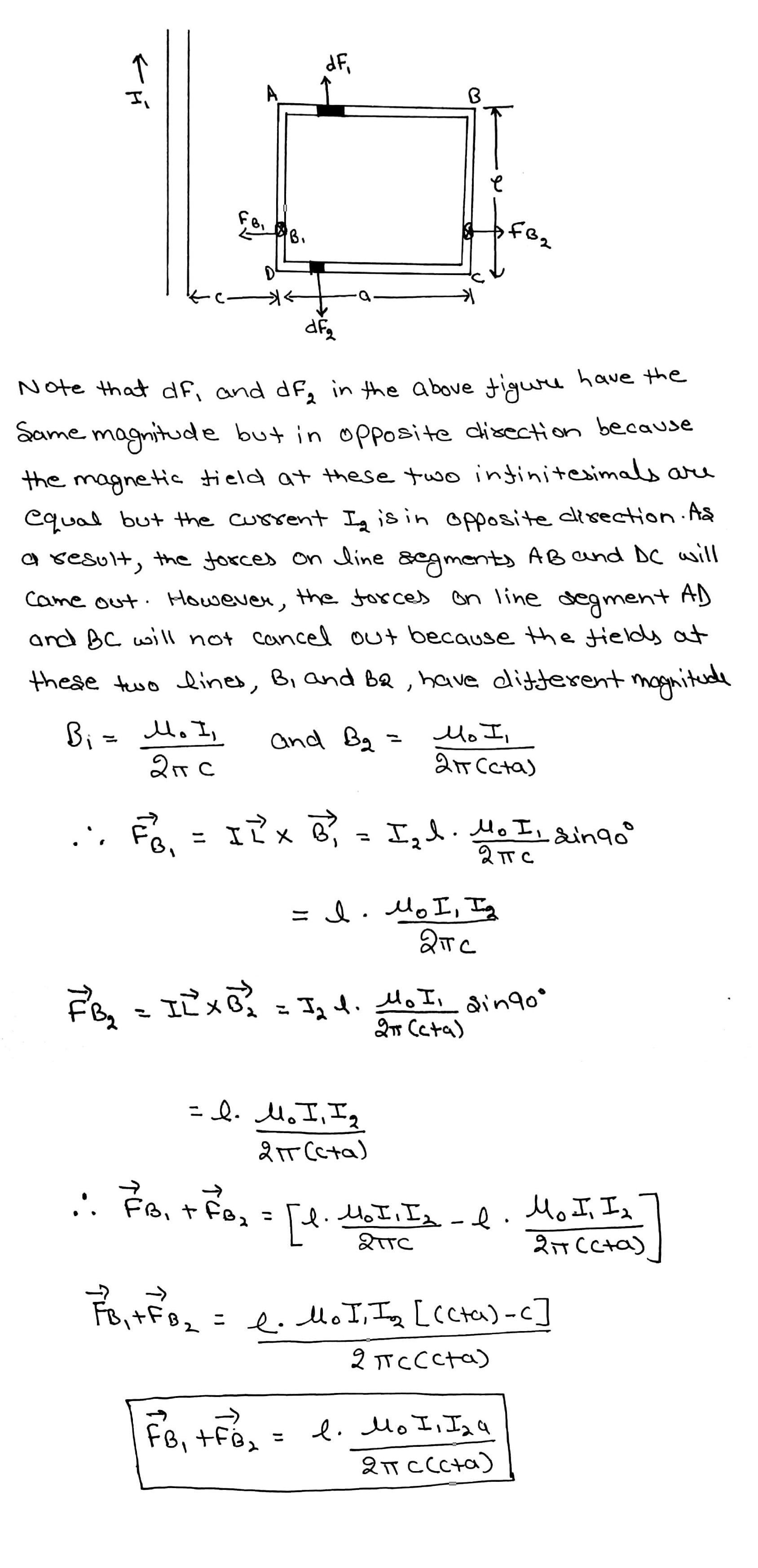Moving Charges And Magnetism - Class 12 Engineering Physics - Extra Questions
When a charged particle moves in a magnetic field normally. Which quantity changes :- the particle's speed or particle's energy or path of motion of the particle?
A magnetic compass shows a deflection when placed near a current carrying wire. How will the deflection of the compass get affected if the current in the wire is increased? Support your answer with a reason.
Which of the following will describe the smallest circle when projected with the same velocity perpendicular to the magnetic field $$B$$
$$\alpha -$$particle?
Compare Biot-Savart law with Coulomb's law for electrostatic field.
In a moving coil galvanometer, what is meant by a radial magnetic field?
Write an underlying principle of the moving coil galvanometer?
Under which condition, an electron moving through a magnetic field experiences maximum force?
What can be the causes of helical motion of a charged particle?
Name any one instrument which works on the principle of tangent law in magnetism
What is the nature of magnetic field in a moving coil galvanometer?
A magnetic compass needle is placed in the plane of paper near point A as shown in Figure 13.In which plane should a straight current carrying conductor be placed so that it passes through A and there is no change in the deflection of the compass? Under what condition is the deflection maximum and why?
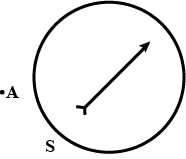
A uniform but time varying magnetic field $$B=Kt-C$$; $$(0\le t\le C/K)$$, where K and C are constants and t is time, is applied perpendicular to the plane of the circular loop of radius 'r' and resistance R. Find the total charge that will pass around the loop in coulombs?
Two long and parallel straight wires A and B carrying currents of 8.0 A and 5.0 A in the same direction are separated by a distance of 4.0 cm. Estimate the force on a 10 cm section of wire A.
The wires which connect the battery of an automobile to its starting motor carry a current of 300 A (for a short time). What is the force per unit length between the wires if they are 70 cm long and 1.5 cm apart? Is the force attractive or repulsive?
Two long straight parallel conductors carry steady current $${ I }_{ 1 }$$ and $${ I }_{ 2 }$$ separated by a distance d. If the currents are flowing in the same direction, show how the magnetic field set up in one produces an attractive force on the other. Obtain the expression for this force. Hence define one ampere.
(a) Write the expression for the magnetic force acting on a particle moving with velocity v in the presence of magnetic field B.
(b) A neutron an electron and an alpha particle moving with equal velocities enter a uniform magnetic field going into the plane as shown. Trace their paths in the field and justify your answer.

A wire AB is carrying a steady current 12 A and is lying on the table. Another wire CD carrying 5 A is held directly above AB at a height of 1 mm. Find the mass per unit length of the wire CD so that it remains suspended at its position when left free. Give the directions of the current flowing in CD with respect to that in AB [Take the value of $$g=10ms^{-2}$$]
Figure below shows two infinitely long and thin current carrying conductors $$X$$ and $$Y$$ kept in vacuum, parallel to each other, at a distance $$'a$$
Define ampere, in terms of force between two current carrying conductors
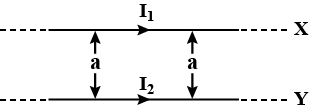
Figure below shows two infinitely long and thin current carrying conductors $$X$$ and $$Y$$ kept in vacuum, parallel to each other, at a distance $$'a$$
How much force per unit length acts on the conductor $$Y$$ due to the current flowing through $$X$$? Write your answer in terms of $$\left (\dfrac {\mu_{0}}{4\pi}\right ), I_{1}, I_{2}$$ and $$a$$.
(Derivation of formula is not required)

Two infinitely long current carrying conductors X and Y are kept parallel to each other, 24 cm apart in vacuum. They carry currents of 5A and 7A respectively, in the same direction, as shown in Figure above. Find the position of a neutral point, i.e. a point where resultant magnetic flux density is zero.
(Ignore earth's magnetic field).

A metallic rod $$CD$$ rests on a thick metallic wire $$PQRS$$ with arms $$PQ$$ and $$RS$$ parallel to each other, at a distance $$l = 40\ cm$$, as shown in following figure. A uniform magnetic field $$B = 0.1T$$ acts perpendicular to the plane of this paper, pointing inwards (i.e., aways from the reader). The rod is now made to slide towards right, with a constant velocity of $$v = 5.0\ ms^{-1}$$.
How much emf is induced between the two ends of the rod $$CD$$?
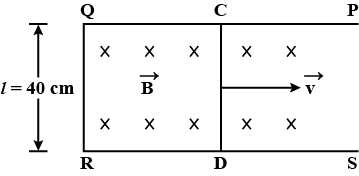
Determine the force acting between two parallel current carrying conductor wires. Write theoretical definition of ampere on this basis.
(i) Define ampere in terms of force between two current carrying conductors.
(ii) What is an ideal transformer?
If current through the conductor Y is reversed in direction, will neutral point lie between X and Y, to the left of X or to the right of Y?

How can you verify that a current carrying wire produces a magnetic field with the help of an experiment?
Derive an expression for the force per unit length acting on the two straight parallel current carrying conductors. In which condition will this force be attractive and repulsive? Define the standard unit of current
What do you understand by Magnetic effect of electric current?
The magnitude $$F$$ of the force between two straight parallel current carrying conductors kept at a distance $$d$$ apart in air is given by
$$F=\dfrac {\mu_0 I_1 I_2}{2\pi d} $$
Where $$I_1$$ and $$I_2$$ are the currents flowing through the two wires.
Use this expression, and the sign convention that the:
Force of attraction is assigned a negative sign and force of repulsion is assigned a positive sign.'
Draw graphs showing dependence of $$F$$ on
$$d$$ when the product $$I_1 I_2$$ is maintained at a constant negative value.
(i) A point charge q moving with the speed $$\upsilon$$ enters a uniform magnetic field $$\vec{B}$$ that is acting into the plane of paper as shown. which is the path followed by the charge q and in which plane does it move ?
(ii) How does the path followed by the charge get affected if its velocity has a component parallel to $$\vec{B}$$?
(iii) If an electric field $$\vec{E}$$ is also applied such that the particle continues moving along the original straight line path , what should be the magnitude and direction of the electric field $$\vec {E}$$ ?
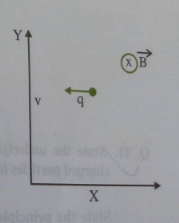
A particle moves in a circle of diameter 1.0 cm under the action of a magnetic field of 0.40 T. An electric field of $$ 200 V m^{-1}$$ makes the path straight . Find the charge / mass ratio of the particle.
Derive formula of magnetic force between two parallel current carrying wires.
Calculate force per unit length acting on the wire B due to the current flowing in the wire A.
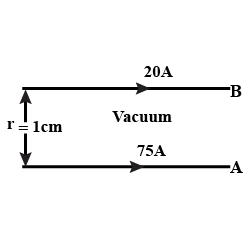
A long horizontal wire P carries a current of $$50$$A. It is rigidly fixed. Another wire Q is placed directly above and parallel to P, as shown in Figure. The weight per unit length of the wire Q is $$0.025$$ $$Nm^{-1}$$ and it carries a current of $$25$$A. Find the distance 'r' of the wire Q from the wire P so that the wire Q remains at rest.
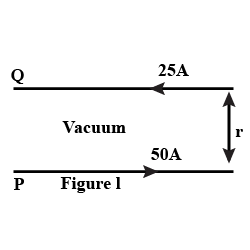
A particle with charge q is projected successively along the x and y axes with same speed v. The force on the particle in these situations are $$qvB(-3\hat{j}+4\hat{k} ) $$ and $$qvB(3\hat{i})$$ respectively. Find the unit vector in direction of $$\overrightarrow {B}$$.
A long straight conductor carrying $$I_1$$ is placed in the plane of ribbon at a distance a from the near edge of a ribbon of width b, which carries $$I_2$$ parallel to the wire. Find the force of attraction per unit length between the two.
Which of the following will describe the smallest circle when projected with the same velocity perpendicular to the magnetic field $$B$$
$$\beta -$$particle?
In a magnetic field, the radius of the circular path b particles is more than that of the path of a particles WHY?
Two parallel wires separated by a distance of $$10\ cm$$ carry currents of $$10\ A$$ and $$40\ A$$ along the same direction. Where should a third current be placed so that it experiences no magnetic force ?
Draw a labelled diagram of a moving coil galvanometer and explain its working. What is the function of radial magnetic field inside the coil?
A charged particle enters the environment of a strong and non-uniform magnetic field varying from point to point both in magnitude and direction and comes out of it following a complicated trajectory. Would its final speed equal to the initial speed, if -it suffered no collisions with the environment?
A proton is projected with a velocity of $$3 \times 10^6 m\,s^{-1}$$ perpendicular to a uniform magnetic field of 0.6 T. Find the acceleration of the proton.
State three ways of increasing the direction on the galvanometer.
Describe some experiment to show that the magnetic field is associated with an electric current.
A coil is connected to a galvanometer. When the $$N-$$ pole of a magnetic is pushed into the coil, the galvanometer deflected to the right. What if, any, is observed when;
The $$S-$$ pole is inserted?
A coil is connected to a galvanometer. When the $$N-$$ pole of a magnetic is pushed into the coil, the galvanometer deflected to the right. What if, any, is observed when;
The magnet is at rest in the coil?
A coil is connected to a galvanometer. When the $$N-$$ pole of a magnetic is pushed into the coil, the galvanometer deflected to the right. What if, any, is observed when;
The $$N-$$ pole is removed?
The wire in Figure is being moved downwards through the magnetic field so as to produce induce current.
What would be the effect of:
Using a stronger magnet?
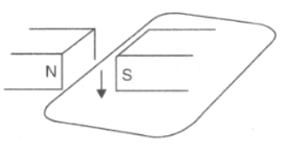
A charged particle moves in a clockwise direction in a magnetic field which is perpendicular to plane of paper directed downwards. What is the nature of charged particle?
Suppose a coil is place in a changing magnetic field and the circuit is not closed will the current induce in the coil?
Two coils $$A$$ and $$B$$ of insulated wire are kept close to each other. Coil $$A$$ is connected to a galvanometer while coil $$B$$ is connected to a battery through a key. What would happen if:
The current is stopped by removing the plug from the key?
Explain your answer mentioning the name of the phenomena involved.
Two coils $$A$$ and $$B$$ of insulated wire are kept close to each other. Coil $$A$$ is connected to a galvanometer while coil $$B$$ is connected to a battery through a key. What would happen if:
A current is passed through coil $$B$$ by plugging the key?
When the magnet shown in the diagram below is moving towards the coil, the galvanometer gives a reading to the right.
State what happens to the reading shown on the galvanometer when the magnet is moving away from the coil.
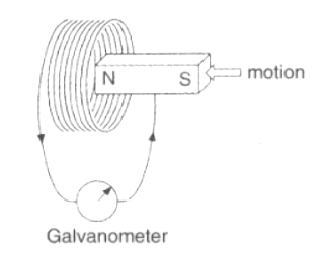
When the magnet shown in the diagram below is moving towards the coil, the galvanometer gives a reading to the right.
What is the name of the effect being produced by the moving magnet?
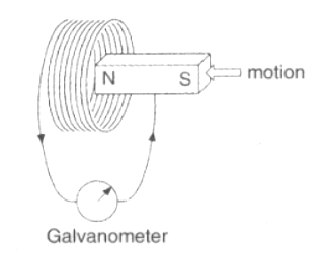
The wire in Figure is being moved downwards through the magnetic field so as to produce induce current.
What would be the effect of:
Holding the wire still in the magnetic field?
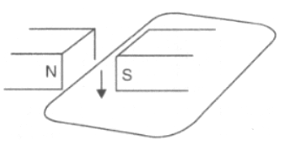
When the magnet shown in the diagram below is moving towards the coil, the galvanometer gives a reading to the right.
The original experiment is repeated. This time the magnet is moving towards the coil at a great speed. State two changes you would notice in the reading on the galvanometer.
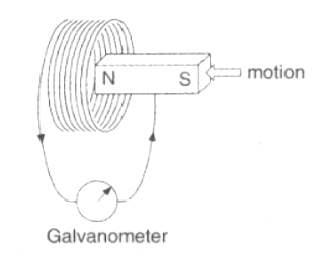
A charged particle moving with a uniform velocity enters a magnetic field directed perpendicular to it, what will be the path of electron? How will its speed be affected?
An $$\alpha$$-particle and a proton are moving in the plane of paper in a region where there is a uniform magnetic field directed normal to the plane of the paper.If the particles have equal linear momentum, what would be the ratio of the radii of their trajectories in the field?
What change in the deflection of the compass needle placed at a point near current carrying straight conductor shall be observed if the (a) current through the conductor is increased? (b) direction of current in the conductor is reversed? (c) compass is moved away from the conductor?
Describe the steps involved in magnetising an iron strip with the help of a magnet.
In the circuit shown in Figure, when the key is closed, the compass needle placed in the matchbox deflects. Name the force which causes this deflection.

Describe an experiment to demonstrate that there is a magnetic field around a current carrying conductor.
How is the magnetic field due to a straight current carrying wire affected if current in wire is (a) decreased. (b) reversed?
Five long wires A, B, C, D and E, each carrying I are arranged to from edges of a pentagonal prism as shown in Fig. 4.Each carries current out of the plane of paper.
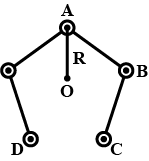
On which factors do the magnetic field due to current carrying conductor depend ?
How will the magnetic field produced in a current carrying circular coil change if we:
increase the value of current ?
Draw the magnetic field lines due to current through circular loop.
Name some devices that use current carrying conductors and magnetic field.
A charged particle does uniform motion in a uniform magnetic field then how would be the path of the particle?
An electric current through a metallic conductor produces a . around it.
In a certain arrangement a proton does not get deflected while passing through magnetic field region under what condition is it possible.
What will happen while placing a current carrying conductor in a magnetic field ? Explain.
Using the relation from the first pair, complete the other.
AC generator: armature.
Moving coil galvanometer:
A proton accelerated by a potential difference $$V =500\ kV$$ flies through a uniform transverse magnetic field with induction $$B = 0.51\ T$$. The field occupies a region of space $$d = 10\ cm$$ in thickness (Fig.). Find the angle $$\alpha$$ through which the proton deviates from the initial direction of its motion.
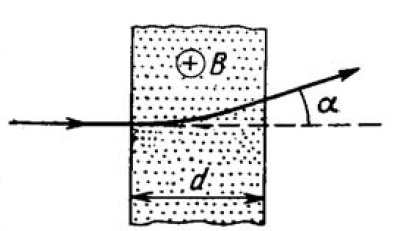
Singly charged ions $$He^{+}$$ are accelerated in a cylcotron so that their maximum orbital radius is $$r = 60\ cm$$. The frequency of a cyclotron's oscillator is equal to $$v = 10.0\ MHz$$, the effective accelerating voltage across the dees is $$V = 50\ kV$$. Neglecting the gap between the dees, find:
(a) the total time of acceleration of the ion;
(b) the approximate distance covered by the ion in the process of its acceleration.
A metal ball of radius $$r$$ moves at a constant velocity $$v$$ in a uniform magnetic field of induction $$B$$.
Indicate the points on the ball the potential difference between which has the maximum value $$\Delta {\phi}_{max}$$. Find this value, assuming that the direction of velocity forms an angle $$\alpha$$ with the direction of the magnetic induction.
A charged particle moves along a circle of radius $$r = 100\ mm$$ in a uniform magnetic field with induction $$B = 10.0\ mT$$. Find its velocity and period of revolution if that particle is
(a) a non-relativistic proton;
(b) a relativistic electron.
A charged particle enters at right angles into a uniform magnetic field is shown. What should be the nature of charge on the particle if it begins to move in a direction pointing vertically out of the page due to its interaction with the magnetic field?
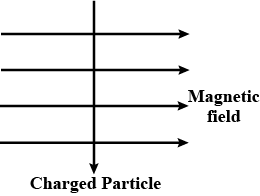
A coil of insulated wire is connected to a galvanometer. What would be seen if a bar magnet with its north pole towards one face of the coil is
(i) Moved quickly towards it,
(ii) Moved quickly away from the coil and
(iii) Placed near its one face?
Name the phenomena involved.
A coil of insulated copper wire is connected to a galvanometer. What will happen if a bar magnet is
(a) pushed into the coil,
(b) withdrawn from inside the coil
(c) held stationary inside the coil?
A particle of charge 1mC and mass 1gm is projected from origin with velocity 20 m/s towards positive x-axis in a nonuniform magnetic field $$\vec{B}=-b_{0}x\hat{k}, $$ where $$b_{0}=\frac{1}{10}T/m$$ and x is in metre. If the maximum positive x-coordinate of the particle during its motion is $$4x_{0}$$ (in cm) then $$x_{0}$$ is (Neglect gravity)
A positively charged particle having charge $$q_1=1C$$ and mass $$m_1=40 gm$$ is revolving along a circle of radius $$R=40 cm$$ with velocity $$v_1=5 ms^{-1}$$ in a uniform magnetic field with center of circle at origin O of a three dimensional system.
At $$t=0$$, the particle was at (0, 0.4 m, 0) and velocity was directed along positive x direction. Another particle having charge $$q_2=1C$$ and mass $$m_2=10 g$$ moving uniformly parallel to positive z-direction will velocity $$v_2=40/\pi ms^{-1}$$ collides with revolving particle at $$t=0$$ and gets stuck to it. Neglecting gravitational force and coulomb force, calculate x-, y- and z-coordinates of the combined particle at $$t=\pi /40 s$$
From the surface of a round wire of radius $$a$$ carrying a direct current $$i$$, a positive charge $$q$$ escapes with a velocity $${v}_{0}$$ perpendicular to the surface. If the maximum distance of the electron is $$\ { x }_{ max }=a{ e }^{ \cfrac { P\pi m{ v }_{ 0 } }{ { \mu }_{ 0 }qI } }$$ will be from the axis of the wire before it turns back due to the action of the magnetic field generated by the current. Find P.
A non-relativistic charge q of mass m originates at a point A lying on x-axis and moves with velocity v at an angle to the x-axis. A screen is located at a distance l from A. If the distance r from the x-axis to the point on the screen into which the charge strikes is $$r=\dfrac {a* mv sin\alpha}{qB}sin \left (\dfrac {qB}{2m}\dfrac {1}{v cos\alpha}\right )$$. Find a.
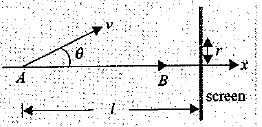
An electron of $$10$$ eV energy is revolving around circular path in magnetic field of $$1\times 10^{-4}$$ weber$$/$$ metre$$^2$$.
Find (i) Speed of electron, (ii) radius of circular path, (iii) time period.
An electron is shot into open end of a solenoid. As it enters the uniform magnetic field within the solenoid its speed is $$800m/s$$ and its velocity vector makes an angle of $${30}^{o}$$ with the central axis of the solenoid. The solenoid caries $$4.0A$$ current and has $$8000$$ turns along its length. Find number of revolutions made by the electron within the solenoid by the time it emerges from the solenoid's opposite end.
(use charge to mass ration $$\cfrac{e}{m}$$ for electron $$=\sqrt 3\times {10}^{11}C/kg$$)
Fill your answer of $$y$$ if total number of revolution is $$\cfrac{y}{5}\times {10}^{6}$$
(a) Explain giving reasons, the basic difference in converting a galvanometer into (i) a voltmeter and (ii) an ammeter.
(b) Two long straight parallel conductors carrying steady currents $${I}_{1}$$ and $${I}_{2}$$ are separated by a distance $$'d'$$. Explain briefly, with the help of a suitable diagram, how the magnetic field due to one conductor acts on the other. Hence deduce the expression for the force acting between the two conductors. Mention the nature of this force.
A current of $$10A$$ passes through two very long wires held parallel to each other and separated by a distance of $$1m$$. What is the force per unit length between them?
A group of particles is travelling in a magnetic field of unknown magnitude and direction. You observe that a proton moving at $$1.50$$km/s in the $$+$$x-direction experiences a force of $$2.25\times 10^{-6}$$N in the $$+$$y-direction, and an electron moving at $$4.75$$ km/s in the $$-$$z-direction experiences a force of $$8.50\times 10^{-16}$$N in the $$+$$y-direction. (a) What are the magnitude and direction of the magnetic field? (b) What are the magnitude and direction of the magnetic force on an electron moving in the $$-$$y-direction at $$3.20$$km/s?
Discuss the motion of a charged particle in a uniform magnetic field.
A stream of deutrons is projected with a variety of $$10^4$$ $$ms^{-1}$$ in XY-plane. A uniform magnetic field of induction $$10^{-3}$$T acts along the Z-axis. Find the radius of the circuit path of particle. (Mass of deuteron is $$3.32\times 10^{-27}$$kg and charge of deuteron is $$1.6\times 10^{-19}$$C).
Electrons emitted with negligible speed from an electron gun, are accelerated through a potential difference $$V$$ along the X-axis. These electrons emerges from a narrow hole into a uniform magnetic field $$B$$ directed along this axis. However, some of the electrons emerging from the hole make slightly divergent angles as shown in figure. Show that these paraxial electrons are refocussed on the x-axis at a distance. $$\sqrt { \cfrac {8 N{ \pi }^{ 2 }mV }{ e{ B }^{ 2 } } } $$.
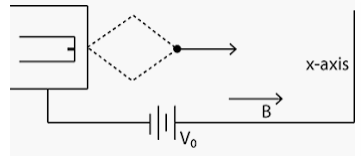
Three very long straight current carrying conductors are placed parallel to each other as shown in the figure. The conductors 1 & 3 are fixed where as conductor 2 is free to move. If the conductor 2 is pulled towards right through a very small distance x, find the net force acting on it and angular frequency of the resulting oscillation.
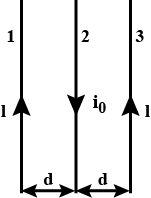
What is the trajectory of the charged particle if the initial velocity of the particle is perpendicular to the direction of the magnetic field?
A particle of mass $$m$$ and positive charge $$q$$, moving with a uniform velocity $$v$$, enters a magnetic field $$B$$ as shown in the figure.
(a) Find the radius of the circular arc it describes in the magnetic field
(b) Find the angle subtended by the arc at the center
(c) How long does the particles stay inside the magnetic field?
(d) Solve the three parts of the above problems if the charge $$q$$ on the particle is negative.

A particle with a charge 2.0 C moves through a uniform magnetic filed. At one instant the velocity of the particle is $$(2.0 \widehat{i}+4.0 \widehat{j}+6.0 \widehat{k})m/s$$ and the magnetic force on the particle is $$(4.0 \widehat{i}+20 \widehat{j}+12 \widehat{k})N$$. The x and y components of the magnetic filed are equal. What is $$\underset{B}{\rightarrow}$$?
Protons and singly ionized atoms of $${ U }^{ 235 }$$ & $${ U }^{ 238 }$$ are passed in turn (which means one after the other and not at the same time) through a velocity selector and then enter a uniform magnetic field. The protons describe semicircles of radius $$10 mm$$. The separation between the ions of $${ U }^{ 235 }$$ and $${ U }^{ 238 }$$ after describing semicircle is given by
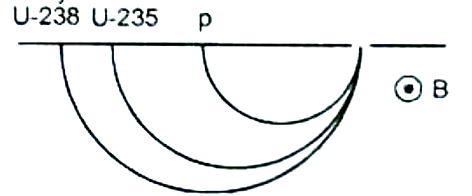
Mention the value of i)Gyromagnetic ratio
Bohr magneton
State the principle of moving coil galvanometer.
State biot-savart law in vector from along with expression.
Two infinite long parallel wires having linear charges densities $${ \lambda }_{ 1 }$$ and $${ \lambda }_{ 2 }$$ respectively are placed at a distance of R meters. The force per unit length on either wire will
$$be\left( k=\dfrac { 1 }{ 4\pi { \in }_{ 0 } } \right) $$
Force experienced by charges 'q' moving with velocity 'V' in a magnetic field 'B' is given by F= qvB. Find the dimensions of magnetic filed .
A particle of mass $$10\ g$$ and charge $$80\ mC$$ moves through a uniform magnetic field, in a region where the free-fall acceleration is $$-9.8\hat{j}\ m/s^{2}$$. The velocity of the particle is a constant $$2\hat{i}\ km/s$$, which is perpendicular to the magnetic field. What, then, is the magnetic field?
A hydrogen atom in its ground state actually has two possble, closely spaced energy levels because the electron is in the magnetic field $$ \overrightarrow B $$ of the proton (the nucleus). Accordingly, an energy is associated with the orientation of the electrons magnetic moment $$ \overrightarrow {\mu} $$ relative to $$\overrightarrow{B}$$ , and the electron is said to be either spin up (higher energy) or spin down (lower energy) in that field. If the electron is excited to the higher-energy level, it can de-excite by spin-flipping and emitting a photon. The wavelength associated with that photon is 21 cm. (Such a process occurs extensively in the Milky Way galaxy, and reception of the 21 cm radiation by radio telescopes reveals where hydrogen gas lies between stars.) What is the effective magnitude of $$ \overrightarrow {B} $$ as experienced by the electron in the ground-state hydrogen atom?
A long straight wire carries a current of $$50 A$$. An electron, traveling at $$1.0\times 10^7 m/s$$, is $$5.0 cm$$ from the wire. What is the magnitude of the magnetic force on the electron if the electron velocity is directed (a) toward the wire, (b) parallel to the wire in the direction of the current, and (c) perpendicular to the two directions defined by (a) and (b)?
Physicist S. A. Goudsmit devised a method for measuring the mass of heavy ions by timing their period of revolution in a known magnetic field. A singly charged ion of iodine makes $$7.00$$ rev in a $$45.0 mT$$ field in $$1.29 ms$$. Calculate its mass in atomic mass units
The figure shows three infinitely long straight parallel current carrying conductors. Find the magnetic force on conductor $$2$$.
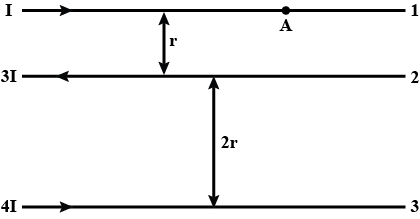
A charged particle enters into a uniform magnetic field and experiences an
upward force as indicated in the figure. What is the charge sign on the particle?

From the surface of a round wire of radius $$a$$ carrying a direct current $$I$$ and electron escapes with a velocity $$v_{0}$$ perpendicular to the surface. Find what will be the maximum distance of the electron from the axis of the wire before it turns back due to the action of the magnetic field generated by the current.
A non-relativistic electron originates at a point $$A$$ lying on the axis of a straight solenoid and moves with velocity $$v$$ at an angle $$\alpha$$ to the axis. The magnetic induction of the field is equal to $$B$$. Find the distance $$r$$ from the axis to the point on the screen into which the electron strikes. The screen is oriented at right angles to the axis and is located at a distance $$l$$ from the point $$A$$.
Demonstrate that electrons move in a betatron along a round orbit of constant radius provided the magnetic induction on the orbit is equal to half the mean value of that inside the orbit (the betatron condition).
Applications Involving Charged Particles Moving in a Magnetic Field(27)
A velocity selector consists of electric and magnetic fields described by the expressions $$\overrightarrow{E}=E\hat{k}$$ and $$\overrightarrow{B}=B\hat{j}$$, with $$B=15.0 \,mT$$. Find the value of $$E$$ such that a $$750-eV$$ electron moving in the negative $$x$$ direction is undeflected.
Applications Involving Charged Particles Moving in a Magnetic Field(31)
The picture tube in an old black-and-white television uses magnetic deflection coils rather than electric deflection plates. Suppose an electron beam is accelerated through a $$50.0-\,kV$$ potential difference and then through a region of uniform magnetic field $$1.00 \,cm$$ wide. The screen is located $$10.0 \,cm$$ from the center of the coils and is $$50.0 \,cm$$ wide. When the field is turned off, the electron beam hits the center of the screen. Ignoring relativistic corrections, what field magnitude is necessary to deflect the beam to the side of the screen?
A proton and an alpha particle having the same kinetic energy are, in turn, passed through a region of uniform magnetic field, acting normal to the plane of the paper and travel in circular paths. Deduce the ratio of the radii of the circular paths described by them.
A square loop of side 20 cm carrying current of 1A is kept near an infinite long straight wire carrying a current of 2A in the same plane as shown in the figure. Calculate the magnitude and direction of the net force exerted on the loop due to the current carrying conductor.
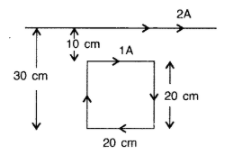
The Magnetic Force Between Two Parallel Conductors(23)
Two parallel wires are separated by $$6.00 \,cm$$, each carrying $$3.00 \,A$$ of current in the same direction.
(a) What is the magnitude of the force per unit length between the wires?
(b) Is the force attractive or repulsive?
The Magnetic Force Between Two Parallel Conductors(26)
In Figure, the current in the long, straight wire is $$I_1$$ and the wire lies in the plane of a rectangular loop, which carries a current $$I_2$$. The loop is of length $$l$$ and width $$a$$. Its left end is a distance $$c$$ from the wire. Find the magnitude and direction of the net force exerted on the loop by the magnetic field created by the wire.
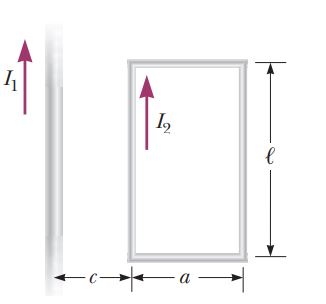
Class 12 Engineering Physics Extra Questions
- Alternating Current Extra Questions
- Atoms Extra Questions
- Current Electricity Extra Questions
- Dual Nature Of Radiation And Matter Extra Questions
- Electric Charges And Fields Extra Questions
- Electromagnetic Induction Extra Questions
- Electromagnetic Waves Extra Questions
- Electrostatic Potential And Capacitance Extra Questions
- Magnetism And Matter Extra Questions
- Moving Charges And Magnetism Extra Questions
- Nuclei Extra Questions
- Ray Optics And Optical Instruments Extra Questions
- Semiconductor Electronics: Materials,Devices And Simple Circuits Extra Questions
- Wave Optics Extra Questions
